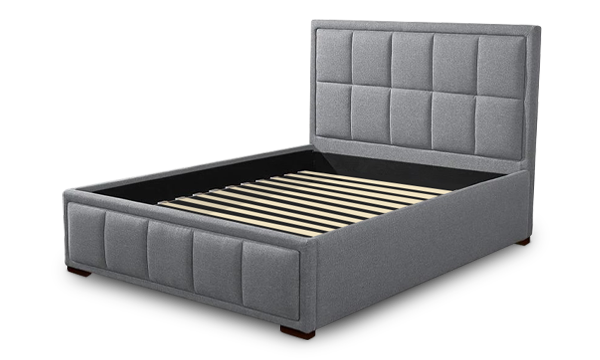When it comes to furnishing a bedroom, selecting the right foundation for your mattress is crucial. The choice between a box spring and a bed frame is more than just a matter of preference; it affects your sleep quality, bedroom aesthetics, and even the longevity of your mattress. Let’s explore the key differences and considerations to help you decide which option best suits your needs.
Difference Between Box Spring and Bed Frame
Box Spring
A box spring is essentially a supportive square box containing springs or a similar form of resistance that absorbs weight placed on the mattress. Traditionally, it’s constructed from a wooden frame covered in cloth, with the springs inside providing a cushioned support for the mattress. Here’s what distinguishes a box spring:
- Shock Absorption: The springs within a box spring provide give, which can contribute to a softer sleeping experience. This absorption of movement can be particularly beneficial for innerspring mattresses, as it enhances the mattress’s ability to flex and contour.
- Elevation: Box springs raise the height of a mattress, making it easier to get in and out of bed. This can be a significant advantage for individuals with mobility issues or those who prefer a higher bed for aesthetic reasons.
- Foundation Support: They distribute the weight and stress on a mattress evenly, which can help in extending the life of the mattress by preventing sagging and wear.
Bed Frame
Bed frames, on the other hand, are more about structure and support rather than cushioning. They come in a wide variety of materials, including wood, metal, and upholstered options, and can include slats or a solid platform to support the mattress. Key features include:
- Versatility in Design: From simple metal frames to elaborate upholstered platforms, bed frames offer a broad spectrum of style choices to complement any bedroom decor.
- Airflow: Many bed frames, especially those with slats, provide better airflow around the mattress, which can help in regulating temperature during sleep and prevent the buildup of mold and mildew.
- Sturdiness and Durability: A solid bed frame can offer robust support for all types of mattresses, including memory foam and latex, without the need for a box spring. This can contribute to the longevity of the mattress by providing a stable base that prevents uneven wear.
Interested in how Puffy stacks up against other brands? Check out our mattress comparisons: Puffy vs Purple, Puffy vs Nectar, Puffy vs Casper, Puffy vs Leesa, Puffy vs Saatva, Puffy vs DreamCloud, and Puffy vs Tuft and Needle.
Bed Frame or Box Spring?
Choosing between a box spring and a bed frame ultimately depends on several factors:
- Mattress Compatibility: Some mattresses, especially modern foam and latex varieties, do not require the additional cushioning of a box spring and can perform better on a firm, supportive surface provided by a bed frame. However, traditional innerspring mattresses might benefit from the shock absorption offered by a box spring.
- Aesthetic and Functional Preferences: If you’re aiming for a particular look or need specific functionality (like storage options available in many bed frames), your choice might lean more towards a bed frame. Conversely, for those seeking simplicity and height, a box spring could be the go-to option.
- Budget and Space Considerations: Generally, a bed frame can be a more economical and space-efficient choice, especially if you opt for a design with built-in storage or one that’s minimalist in nature.
When considering a new setup for your bedroom, think about the compatibility with your mattress. For instance, Puffy mattresses are designed to provide optimal comfort and support on any sturdy surface.
Check out Puffy mattress reviews from real customers and see how we compare with other brands.
Pros and Cons
Box Spring
Pros:
- Enhanced mattress support and longevity.
- Increased bed height, making getting in and out of bed easier for some.
Cons:
- Limited style options.
- Can wear out over time, affecting mattress support.
Bed Frame
Pros:
- Wide variety of styles and materials.
- Generally offers better airflow around the mattress.
Cons:
- Some designs may require periodic tightening of screws to prevent squeaks.
- May not provide the same level of shock absorption as box springs.
Transitioning from a traditional box spring to a sleek, modern bed frame made a significant difference in our bedroom’s look and feel. The change was not just aesthetic; we noticed improvements in our sleep quality, partly due to the stable support and increased airflow around our mattress. Our Puffy Lux Mattress, in particular, felt more supportive on the new bed frame, highlighting the importance of matching your mattress with the right foundation.
Use our store locator to find the closest furniture or mattress store near you and feel the cloudlike comfort of our Puffy Mattress in person.
Conclusion
Choosing between a box spring and a bed frame boils down to personal preference, mattress compatibility, and bedroom design goals. While box springs offer traditional support and height, bed frames provide versatility in style and are often more durable. Consider your priorities, whether it’s aesthetic appeal, budget, or specific mattress requirements, to make the best choice for your sleeping haven.

- Premium stitching.
- Heavy-duty wooden frame.
- Lifetime warranty.
- 101-night sleep trial.
- Free shipping and returns.












